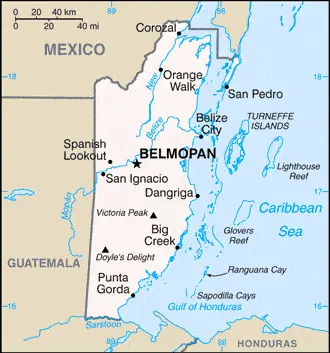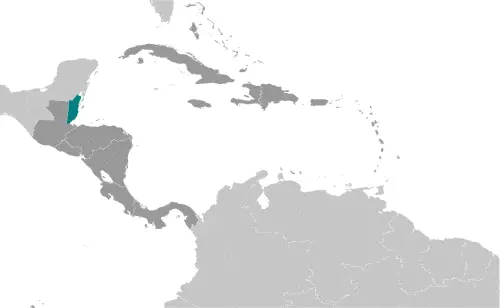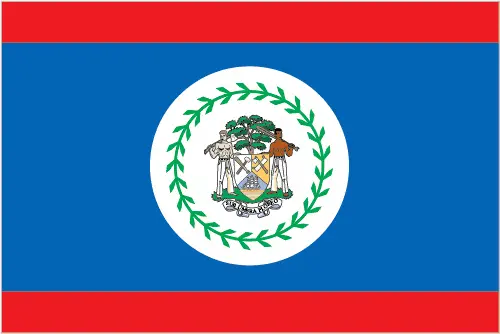Google Maps and Detailed Facts of Belize (BZ). This page lets you explore Belize and its border countries (Country Location: Central America, bordering the Caribbean Sea, between Guatemala and Mexico) through detailed Satellite imagery – fast and easy as never before Google Maps.
Find comprehensive information about this country’s diversity below: Google maps, geography, economy, science, people, culture, environment, government, and history – All in One Wiki page.
There is also a Street View and free Driving Directions at your service. Your Google Satellite Map Sightseeing in Belize, Central America, and the Caribbean starts here at Driving Directions and Maps.com.
About Belize in detail
Table of contents
- Background
- Overview
- Google Maps
- Climate
- Geography
- Resources and Land Use
- Population Data
- Economic Data
- Drinking Water Source
- Population, Median Age, Migration, and Citizenship
- Average Number of Childbirths
- Is this country a Safe Destination?
- Healthcare and Infectious Diseases
- Natural Hazards
- The Flag and Other Symbols
- Constitution
- Legal System
- About the Unemployment Rate, Labor Force, and Poverty Line
- About the Budget and Central Government Debt
- Inflation Rate and Prime Lending Rate
- Export/Import Partners and Data
- Renewable Energies Used
- Telecommunication Data, Calling Code
- Transport Infrastructure
- More Interesting Facts
Background
Belize, previously known as British Honduras, became independent in 1981 after a history marked by Mayan civilization, British and Spanish disputes, and a prolonged period of colonial rule. The nation’s journey to sovereignty was complicated by territorial disputes with Guatemala, a neighboring country that did not recognize Belize’s independence until 1992. These disputes continue to be a point of contention, requiring intervention from the International Court of Justice. Belize’s economy has undergone significant transformation, with tourism now being a key driver, alongside concerns such as high foreign debt, crime rates, and challenges associated with its involvement in the regional drug trade.
Overview
Located in Central America, Belize borders the Caribbean Sea, Guatemala, and Mexico. With a slightly smaller area than Massachusetts, Belize boasts a rich ecological diversity, including flat, swampy coastal plains and low mountains in the south. Its population of approximately 419,137 people enjoys a tropical climate with distinct rainy and dry seasons. The nation is the only country in Central America without a coastline on the North Pacific Ocean, making it unique in the region.
Official Name: Belize
Date of Formation: 21 September 1981 (from the UK)
Capital: Belmopan
Population: 419,137 (2023 est.)
Total Area: 8,867 Sq. Miles / 22,966 Sq. Km
Population Density: N/A
Languages: English 62.9% (official), Spanish 56.6%, Creole 44.6%, Maya 10.5%, German 3.2%, Garifuna 2.9%, other 1.8%, unknown 0.5% (2010 est.)
Religions: Roman Catholic 40.1%, Protestant 31.5% (includes Pentecostal 8.4%, Seventh Day Adventist 5.4%, Anglican 4.7%, Mennonite 3.7%, Baptist 3.6%, Methodist 2.9%, Nazarene 2.8%), Jehovah’s Witness 1.7%, other 10.5% (includes Baha’i, Buddhist, Hindu, Church of Jesus Christ, Muslim, Rastafarian, Salvation Army), unspecified 0.6%, none 15.5% (2010 est.)
Ethnic Origin: Mestizo 52.9%, Creole 25.9%, Maya 11.3%, Garifuna 6.1%, East Indian 3.9%, Mennonite 3.6%, White 1.2%, Asian 1%, other 1.2%, unknown 0.3% (2010 est.)
Government: Parliamentary democracy (National Assembly) under a constitutional monarchy; a Commonwealth realm
Currency: Belizean dollar (BZD)
Literacy Rate: N/A
Calorie Consumption: N/A
Belize Google Maps
Google Maps serves as an essential guide for exploring Belize’s diverse landscape, from the bustling streets of Belize City to the serene beaches along its Caribbean coast. It offers comprehensive and detailed mapping services, making it an indispensable tool for both locals and tourists navigating this tropical paradise.
Belize lies on the eastern shore of the Yucatan Peninsula. Formerly called British Honduras, Belize was the last Central American country to gain its independence in 1981. Almost half the land area is forested. Low mountains in the southeast. Flat, swampy coastal plains.
The map below shows Belize’s cities, towns, highways, main roads, streets, and Street Views. To find a location, use the form below, type any city or place, view a simple map, and click the “show map” button.
The Google map above shows Belize with its location: Central America and the Caribbean (geographic coordinates: 17 15 N, 88 45 W) and the international borders of Belize; total: 542 km. Border countries (total: 2): Guatemala 266 km, Mexico 276 km; furthermore, it’s inland counties boundaries.
The map of Belize, Central America, and the Caribbean is for informational use only. No representation is made or warrantied given any map or its content by Driving Directions and Maps site. The user assumes all risks of using this Belize Google map and facts/wiki.
Climate
Belize, a country known for its stunning natural beauty and vibrant culture, is also defined by its tropical climate. This climate, characteristic of hot and humid conditions, significantly influences the nation’s environment, lifestyle, and economic activities.
- Distinct Seasons: Belize’s climate is primarily divided into two seasons: the rainy and the dry. The rainy season spans from May to November; the country receives most of its annual rainfall. This period is often characterized by heavy, short bursts of rain, typically in the afternoon or evening, which can lead to lush green landscapes and pose challenges such as flooding in certain areas.
- The Dry Season: On the other hand, the dry season, lasting from February to May, is marked by significantly lower rainfall. This period is ideal for tourists who prefer sunny, warm weather, making it a peak season for the tourism industry. The dry season is not completely devoid of rain, but showers are less frequent and intense.
- Temperature Variations: Throughout the year, temperatures in Belize remain relatively consistent, typically ranging between 24°C to 27°C (75°F to 80°F). However, the coastal areas tend to be slightly cooler due to sea breezes, while the inland regions, especially the western part of the country, experience hotter temperatures.
- Humidity and Comfort: The humidity levels in Belize are generally high, contributing to the feeling of warmth. The humidity, combined with the heat, can make the climate feel quite intense, particularly during the peak of the rainy season.
- Impact on Agriculture: The variation in weather plays a crucial role in Belize’s agricultural sector. The start of the rainy season is typically the planting period for many crops, while the dry season is favorable for harvesting. Key agricultural products like sugar, citrus, and bananas depend heavily on this seasonal weather pattern.
- Tourism and Ecological Impact: Tourism in Belize, particularly activities like diving, snorkeling, and visiting ancient Maya ruins, is highly influenced by the climate. The dry season is preferred for these activities, attracting more tourists. However, the changing climate patterns, possibly influenced by global climate change, pose challenges to both natural ecosystems and tourism industries.
- Climate Change Concerns: Like many tropical regions, Belize faces the threat of climate change, which could lead to more severe weather events, rising sea levels, and increased vulnerability of its coastal and marine ecosystems. Efforts to monitor and mitigate the effects of climate change are crucial for the country’s environmental sustainability and economic stability.
In summary, Belize’s tropical climate, with its clear division between the rainy and dry seasons, plays a fundamental role in shaping the country’s natural environment, agricultural practices, and tourism industry. The consistent warm temperatures and varying humidity and rainfall create a challenging and beneficial climate for different sectors of Belizean society.
Geography
Belize’s geography is diverse and crucial to its ecological and cultural identity. Located in Central America, this nation boasts a landscape that ranges from coastal beauty to mountainous terrains.
- Coastal Plains and Mountains: Most of Belize’s landscape comprises a flat, swampy coastal plain. This region is characterized by its lush, fertile soil, making it suitable for agriculture and habitation. Moving inland, the terrain transitions into low mountains, particularly in the southern part of the country. The Maya Mountains, a significant mountain range in this region, host Doyle’s Delight, the highest point in Belize, standing at 1,124 meters (3,688 feet). This peak, named after Sir Arthur Conan Doyle, is a part of Belize’s rich natural heritage.
- Forest Cover: Belize is distinguished by its extensive forest cover, which accounts for a substantial part of the country’s land area. These forests are diverse in composition, including broadleaf forests and pine savannas. They serve as crucial habitats for a wide range of flora and fauna and are important for maintaining the ecological balance.
- Marine Resources: The Belize Barrier Reef, part of the larger Mesoamerican Barrier Reef System, is one of the most remarkable aspects of Belize’s geography. It is the second-largest barrier reef in the world and a UNESCO World Heritage Site. This reef system is home to many marine species and is vital for the fishing industry and attracting tourists, especially divers and snorkelers.
- Rivers and Waterways: Belize is rich in water resources, with numerous rivers and streams crisscrossing the country. The longest river is the Belize River, which plays a significant role in transportation and agriculture. These waterways are essential for irrigation and are also popular for recreational activities like canoeing and fishing.
- Surrounding Countries and Territorial Waters: Belize is bordered to the north by Mexico, to the west and south by Guatemala, and to the east by the Caribbean Sea. The proximity to these countries adds to Belize’s cultural and economic dynamics. The territorial waters of Belize are significant, not only because of the barrier reef but also due to the abundant marine life they support.
- Climate Impact on Geography: The geography of Belize is also influenced by its tropical climate. The coastal areas are susceptible to hurricanes and tropical storms, which can cause significant changes in the landscape, including coastal erosion and flooding. The forests and mountainous regions provide natural barriers against these climatic impacts.
In summary, Belize’s geography is marked by its flat, swampy coastal plains, low mountains in the south, significant forest cover, and remarkable marine resources, including the Belize Barrier Reef. Its position in Central America, bordered by Mexico, Guatemala, and the Caribbean Sea, adds to its geographical and cultural richness. The diverse landscape supports a variety of ecosystems and is crucial for the country’s economy, particularly in sectors such as agriculture, tourism, and fishing.
Resources and Land Use
Belize’s natural resources include potential arable land, timber, fish, and hydropower. Land use primarily focuses on agriculture (6.9%) and forests (60.6%), reflecting the country’s dependence on its natural environment for economic and social development.
Population Data
Belize’s population in 2023 is estimated at 419,137, with a significant portion residing in Belize City, the largest city and former capital. The country has a relatively young population, with a median age of 26.4 years and about 46.6% of its population living in urban areas.
Economic Data
Belize’s economy is primarily driven by tourism and agriculture. It has shown resilience and adaptability, especially with innovative approaches to debt restructuring and expanding marine protections. The nation’s real GDP in 2021 was estimated at $3.505 billion, demonstrating post-pandemic economic recovery.
Drinking Water Source
Belize has made considerable progress in ensuring access to improved drinking water, with 100% of the urban population and 99.4% of the rural population having access to improved water sources as of 2020.
Population, Median Age, Migration, and Citizenship
The median age of Belize’s population is 26.4 years. The country has a net migration rate of 1.8 migrants/1,000 population. Belizean citizenship is primarily based on birth within the territory, and the nation recognizes dual citizenship.
Average Number of Childbirths
The average number of childbirths per woman in Belize is 2.08, reflecting the country’s youthful demographic profile and its implications for future population growth and social development.
Is this country a Safe Destination?
Belize is generally considered safe for travelers, but it is advisable for visitors to be cautious, especially in areas with higher crime rates. Natural hazards include frequent hurricanes from June to November and coastal flooding, particularly in the south.
Healthcare and Infectious Diseases
Belize’s healthcare system offers a range of services focusing on improving access and quality. The country faces healthcare challenges similar to other Central American nations, with a high prevalence of HIV/AIDS being a significant concern.
Natural Hazards
The primary natural hazards in Belize are hurricanes and coastal flooding. The nation’s geographical location makes it susceptible to these weather-related events, particularly during the hurricane season.
The Flag and Other Symbols
The national flag of Belize features royal blue with a narrow red stripe along the top and bottom edges and a large white disk bearing the coat of arms. The flag symbolizes the nation’s history and its political journey. Other national symbols include Baird’s tapir, the keel-billed toucan, and the Black Orchid.
Constitution
Belize’s constitution, adopted on the day of its independence in 1981, establishes the framework for a parliamentary democracy under a constitutional monarchy. It has been amended several times to reflect the evolving political and social landscape.
Legal System
Belize follows the English common law system. It has integrated elements from international law, particularly in areas concerning human rights and environmental protection, to create a legal framework that is both modern and comprehensive.
About the Unemployment Rate, Labor Force, and Poverty Line
The unemployment rate in Belize was estimated at 8.22% in 2021. Despite its natural beauty and resources, the country faces significant challenges with poverty, with approximately 41% of the population living below the poverty line as of 2013.
About the Budget and Central Government Debt
Belize’s national budget reflects a delicate balance between revenue and expenditure, with a public debt of 99% of GDP in 2017. Fiscal management remains a crucial aspect of the government’s economic strategy.
Inflation Rate and Prime Lending Rate
The inflation rate in Belize was 3.24% in 2021. The prime lending rate is a key economic indicator, influencing investment and consumption patterns within the country.
Export/Import Partners and Data
Belize’s main export partners include the United States, the United Kingdom, and Guatemala, with major exports being raw sugar, bananas, and seafood. The country primarily imports recreational boats, refined petroleum, and natural gas, with the United States, China, and Seychelles being key import partners.
Renewable Energies Used
Belize is gradually transitioning towards renewable energy sources, focusing on hydropower and biomass. The country’s energy policy aims to reduce dependency on fossil fuels and promote sustainable energy development.
Telecommunication Data, Calling Code
Belize has a developing telecommunications infrastructure with increasing mobile phone usage and internet penetration. The country code for Belize is +501.
Transport Infrastructure
Belize has a modest transport infrastructure, including roadways, airports, and waterways. The country’s transport network is crucial for connecting its regions and supporting key economic sectors like tourism and agriculture.
More Interesting Facts
Belize, a country rich in natural beauty and cultural diversity, offers a treasure trove of fascinating facts that many might not know. Here are some intriguing “Did you know” facts about Belize:
Did you know?
- The Only Country in Central America Without a Pacific Coastline: Unlike its neighbors, Belize is unique in Central America as it is the only country without a coastline on the Pacific Ocean. Instead, its shores are bathed by the Caribbean Sea, contributing to its rich marine biodiversity.
- Home to the Second Largest Barrier Reef: Did you know that Belize boasts the second-largest barrier reef in the world? The Belize Barrier Reef is a UNESCO World Heritage site and spans over 300 kilometers (186 miles). It’s a haven for divers and snorkelers exploring its vibrant marine life.
- A Melting Pot of Cultures: Belize is a cultural melting pot with a diverse population. This includes the Kriols, Mestizos, Maya, Garifuna, and more. Each group contributes to the rich tapestry of Belize’s cultural heritage, seen in the country’s languages, music, dance, and festivals.
- Ancient Mayan Civilization: Belize was once a central part of the Mayan civilization. Today, it is home to more than 600 ancient Mayan sites. The most famous among these is Caracol, which, at its peak, was one of the most important Mayan political centers.
- The Great Blue Hole: One of Belize’s most famous natural wonders is the Great Blue Hole, a giant marine sinkhole off the coast. Measuring over 300 meters (984 feet) across and 125 meters (410 feet) deep, it is a popular spot for scuba divers, famous for its crystal-clear waters and diverse marine life.
- Official Language: While it’s nestled in Central America, Belize is the only country in the region where English is the official language, a remnant of its history as a British colony.
- A Haven for Jaguars: Belize is home to the world’s first jaguar preserve, the Cockscomb Basin Wildlife Sanctuary. This sanctuary covers about 150 square miles and is dedicated to protecting and studying jaguars and other wildlife.
- Cashew Wine: Apart from the more commonly known products like rum, Belize is also known for its unique cashew wine, made from the fermented juice of cashew apples.
- Belize’s Unusual Time Zone: Interestingly, Belize operates on Central Standard Time but does not observe Daylight Saving Time. This practice sets it apart from its neighboring countries, which typically adjust their clocks.
- The Capital City’s Relocation: Belize is one of the few countries that have moved its capital city. After Hurricane Hattie severely damaged Belize City in 1961, the capital was moved to Belmopan, one of the world’s smallest capital cities.
These facts about Belize offer a glimpse into its unique blend of natural wonders, ancient history, and cultural diversity. From its world-renowned barrier reef to the remnants of the Mayan civilization, Belize is a country of rich and varied experiences.
Many thanks for visiting and sharing this map & country information site!



